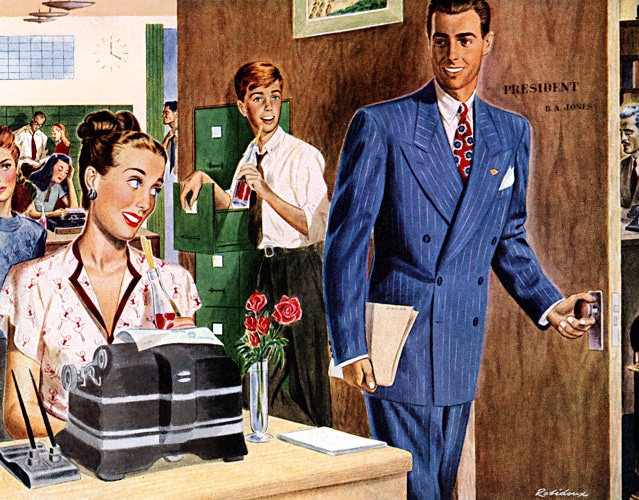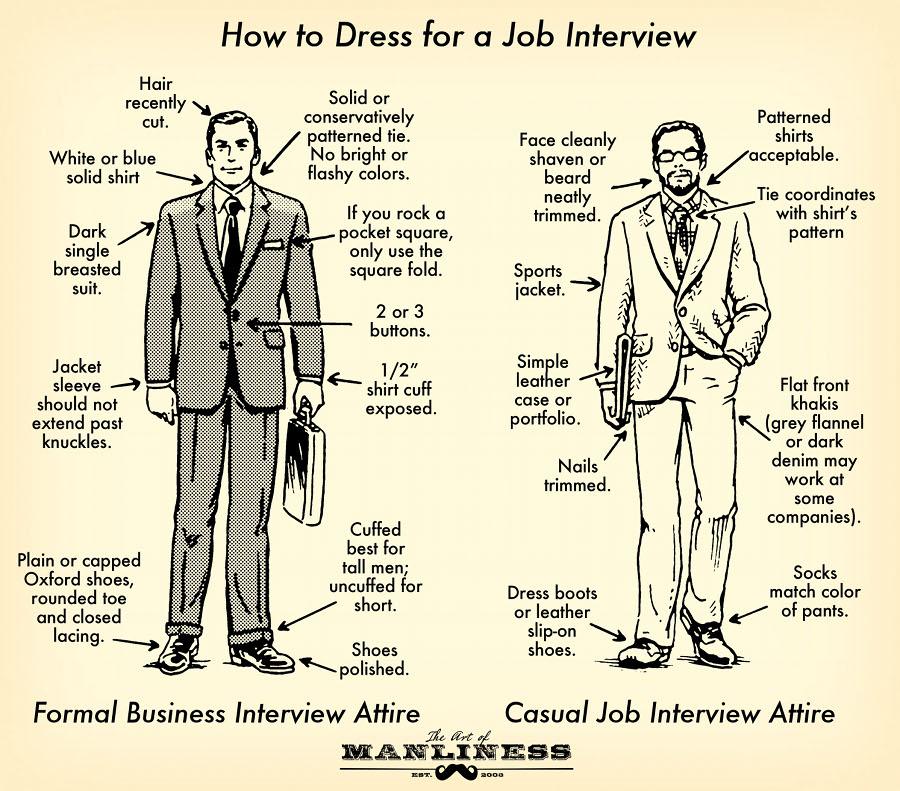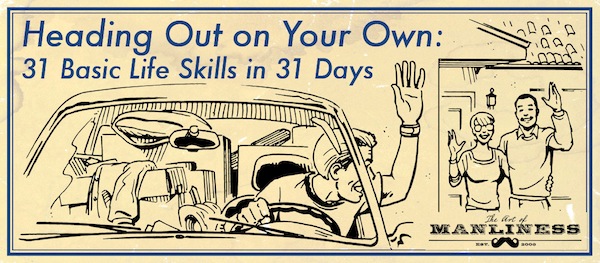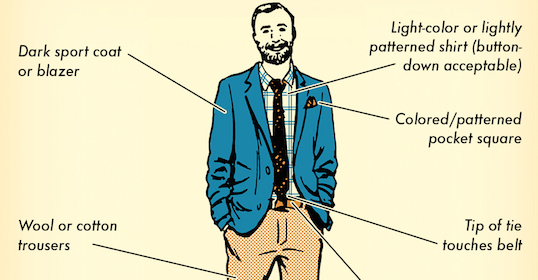
We are reminded daily that the economic outlook isn’t good; for those of us looking for work, it’s hard to imagine a worse scenario. Not only are there less jobs out there, the number and quality of people applying for them continues to rise.Interviews have gone from competitive to ultra-competitive.
This article deals with how to dress for a job interview. What you wear to an interview is important because it is a factor you can control, unlike other factors such as who will interview you or what questions will be asked. Not dressing appropriately is one of the most common ways job seekers shoot themselves in the foot; it immediately signals to the interviewer that you did not properly prepare and damages your chances for the position. In today’s ultracompetitive job market, why would you let something so simple get in your way?
Although focused on interviews that require a suit and tie, many of the tips and techniques translate into any situation in which you want to present yourself as a prime candidate for employment. These tips can stand alone if you are applying for an entry level position where only a button up shirt and nice slacks are required.
Watch the Video
The Interview Suit
The good news is that the classical men’s suit style has remained the same for a hundred years. The bad news is that there are a lot of fashion suits out there that will become dated faster than you can purchase them. You need to ignore temporary fashion, and find what looks best on you. Remember three things when choosing a suit: Fit, Style, and Fabric.
Your Suit’s Fit
The majority of American men wear suits too large for them.The problem is a result of trying to fit into a garment made to fit as many men as possible.It is always a good investment to have anything bought off the rack adjusted by a competent tailor, but first you need to find one that comes close to fitting. When inspecting your suit’s fit, first ensure the chest and shoulders fit you snugly – you should have full freedom of movement with your arms and a few inches of room in the chest but not so tight as to form an “X” when buttoned.The jacket should be long enough to just cover your backside and not extend past your hand’s knuckles when your arms are held straight down.Ensure your sleeves show ½ inch of shirt cuff and that the jacket lapels lay flat on your chest. Finally there should be no bunching of fabric in the back near your neck ,and your jacket collar should show approximately ¾ of an inch of your shirt’s collar.
Your Suit’s Style
When it comes to interview suit style, go with a classic cut that is common in your country. In the United States, this is a single breasted, notched lapel, two or three button jacket with a single or double back vent and regular flap pockets. Ensure you have at least as many cuff buttons as you have front jacket buttons (four buttons on the sleeve is normal) and make sure you have a left breast pocket (on some trendy suits these are missing). Avoid patch pockets, peak lapels, and slanted side pockets (in the US) as all of these change the formality of the jacket and are best left to non-interview attire. Also pay close attention to the lapels; a trend right now is thin lapels, which if worn by a large man will make him look ridiculous. As for trousers, either flat or pleated slacks are fine, although pleated fronts are more formal and generally more comfortable. Cuffed bottoms look best on tall men while shorter men are advised to wear their trousers uncuffed; either is perfectly acceptable for an interview.
Your Suit’s Fabric
When selecting your suits fabric take into consideration its weave and color. Try to go with natural fibers, preferably worsted wool. If you choose a blend, ensure the synthetic fiber make-up is 40% or less. Although a blend may keep the price down, it will normally not last as long and may be less breathable. As to color choice, the safest selections are solids in navy blue, charcoal, and black. Although you can wear patterns such as pin stripes or colors such as brown or taupe, understand you will stand out.
The Dress Shirt
Again, focus on fit, style, and fabric. The dress shirt’s fit should be loose enough to allow a full range of movement but not so loose as to have excess fabric bunching up under the jacket.Your shirt should be long enough so that when you bend over, it does not un-tuck. You also want to be able to place two fingers in-between your neck and a buttoned collar – any more and it just looks too loose. Your cuffs should extend to the top of your hands, with approximately ½ inch of shirt cuff showing from under your jacket sleeve when your arms hang straight down. The cuff should not be too loose; you should have to unbutton it to remove it.
As for style, the collar type chosen should be based off of your facial structure. Men with long, thin faces look best in spread collars, while round faced men should look to even out their appearance with a point collar. Avoid button down collars in an interview, as they are the least formal. Normal barrel cuffs with one or two buttons are fine for interviews; avoid cufflinks unless you have the resume to back them up.
Your shirt’s fabric should be simple and non-flashy – white and blue solids are a staple and easy to find; those that desire more can transform these colors with a unique weave such as herringbone or oxford.Avoid colors such as lavender and pink and patterns such as checks, as they make an outfit less formal; stripes should only be worn if the wearer understands how to match patterns.
Your Tie
Interview ties should be conservative and made from silk. Solid or simple patterns in red, blue, or gold are all acceptable; however, a skilled dresser can often incorporate almost any non-attention grabbing color and pattern.Striped ties are a fine choice and come in a wide range of colors, but ensure the tie you choose is not sporting a regimental pattern. In the UK, memberships to military clubs and other groups are symbolized by certain ties.Wearing another man’s “Colors” can cause a confrontation and embarrassment.And unless it’s an interview over a meal, there is no reason to use a tie clip or pin (where it serves to hold a man’s tie in place). The key thing to remember is to keep it professional – avoid bright colors or designs that will draw undue attention.
Dress Shoes
Your shoes are the foundation of your outfit; do not skimp on this detail – they are as important as your suit.With that being said, anything well polished, dark, and not screaming “look at me!” will probably work in the US for an interview; in Europe they are generally more in tune to these details, so be careful.A plain or capped black oxford is always a safe choice; classic in nature, a quality pair will serve you well for years. Whichever shoes you choose, try to make sure they have round toes and closed lacing. By closed lacing, I mean that the two sides of the upper that are pulled together by the lacing are sewn under the front part of the shoe.A small detail, but it gives the foot a sleeker look and will ensure your shoe is the right choice for a suit.You should not wear slip-ons such as dress boots, loafers, or monkstraps, and avoid anything eccentric.
Hosiery
Your socks should match your slacks or shoes and be dark in color. The goal here is to not draw attention to your legs. This isn’t the time to sport the no sock/short sock look or try that new pair of flashy hosiery. If the socks are seen, they should appear to flow seamlessly between the shoes and trouser cuff. No White Socks!
Jewelry and the Interview
A wedding ring is always acceptable in an interview; anything else is fair game and left up to the interviewer’s personal views. I advise against wearing class rings or anything else on the fingers.As for watches, think less is more – keep it simple, understated, and please turn off the alarm. Although jewelry such as nose rings, eye piercings, and earrings have become more accepted in our society, these things are still considered out of the ordinary for many; you cannot wear something like this and not expect it to affect a person’s impression of you. Be yourself, but be aware of the consequences.
Grooming
Get a haircut a week before the interview and ensure they trim around your neck and ears – consider grooming these two areas again the day before. Pay attention to the details – your nails should be clean and cut, your face appropriately shaven, and your hair should have been washed within the last 24 hours. It’s not a date, so avoid cologne and be careful with the aftershave; sometimes interviews are held in small rooms and you do not want to overpower your interviewer’s olfactory system.
Preparation
You do not need to have your clothing dry cleaned, but everything you wear must be look and smell clean (no smoking around your interview clothing).Shirts should be ironed, shoes polished, and have a suit steamed to remove wrinkles.Have all of this done well in advance of the interview – saving this for the last minute is asking for trouble.
Remember This
Your interview attire will not get you a job – but failing to manage it can hurt your chances for a position.Your aim in dressing well is to present yourself in the best possible light throughout your interview.Wear clothing that fits, is made of quality material, and is appropriate for the interview.By doing these simple things you ensure the interviewer focuses on your skills and what you have to offer; not your appearance.
Written by Antonio Centeno
President, A Tailored Suit
Join our Facebook Community and Win Custom Clothing
Need more men’s fashion information? Visit our Style Guide.







